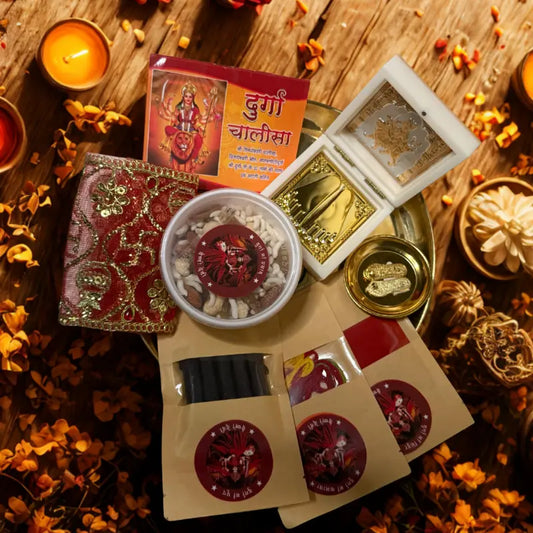
Navratri Prasad for 9 Days: Complete Guide with Spiritual Significance
Share
Introduction
Navratri, the nine-night festival dedicated to Goddess Durga, is one of the most significant spiritual celebrations in Hindu culture. During this festival, devotees prepare and offer special Navratri prasad for nine days, also known as Navratri bhog or Navratri food offerings, which are rich in both nutritional value and spiritual significance. These offerings symbolize devotion, purity, and the surrender of worldly attachments, while also invoking the divine blessings of Goddess Durga.
This article will guide you through the spiritual significance and types of prasad or bhog you can prepare for each of the nine days of Navratri.

What is Navratri Prasad?
Navratri prasad for nine days refers to the sacred food offerings made during the nine-day festival, prepared with natural and pure ingredients. These offerings vary each day, reflecting different aspects of Goddess Durga’s manifestations. They are often simple yet deeply spiritual, representing purity, devotion, and a connection with the divine. The prasad, when made with devotion, is believed to bring blessings of prosperity, health, and wisdom.
Significance of Navratri Food Offering
Navratri bhog holds immense spiritual significance, as each food offering is intended to honor Goddess Durga and invite her blessings. These offerings are typically vegetarian, symbolizing purity and non-violence, which are important principles in Hinduism. The food is prepared with the intention of invoking divine energies and is offered to the Goddess before being shared with family and friends.
The act of offering prasad signifies devotion and an expression of gratitude for the Goddess's blessings. The prasad is also believed to have the power to purify the soul and body, fostering a deeper connection with the divine.
Day-by-Day Guide to Navratri Prasad
Day 1: Pratipada – Sweetened Kalash and Coconut Prasad
On the first day, a sacred offering of sweetened coconut and sugar is placed in a kalash (a sacred pot), symbolizing the start of the divine festival.
- Significance: The coconut represents purity and auspiciousness, and the offering is said to invoke blessings of prosperity.
Day 2: Sooji Halwa (Semolina Pudding)
Sooji Halwa is one of the most common Navratri food offerings. Made from semolina, ghee, and sugar, it is a deliciously rich prasad often flavored with cardamom.
- Significance: Sooji Halwa represents the sweetness of life and divine blessings.
Day 3: Sabudana Khichdi (Tapioca Khichdi)
Made from tapioca pearls, Sabudana Khichdi is a light, savory dish prepared with cumin, green chilies, and peanuts.
- Significance: It’s a perfect fasting dish that nourishes both the body and soul, symbolizing the sustenance provided by the Goddess.
Day 4: Fruit Salad with Honey
On the fourth day, a simple fruit salad mixed with honey is offered as a prasad, symbolizing nature’s sweetness.
- Significance: Fruits are considered pure offerings, symbolizing the fertility and abundance of nature.
Day 5: Kuttu Ka Atta (Buckwheat Flour) Pancakes
Buckwheat flour pancakes, or Kuttu ka Atta, are offered on the fifth day of Navratri. These pancakes are made with ghee and are a popular fasting dish.
- Significance: The offering symbolizes humility and the transition from material desires to spiritual awakening.
Day 6: Aloo (Potato) Chaat
Aloo Chaat is a tangy and spicy dish made with boiled potatoes, yogurt, and spices, often offered as a prasad on the sixth day of Navratri.
- Significance: Potatoes are considered grounding and symbolize stability in spiritual practice.
Day 7: Makhana Kheer (Fox Nut Pudding)
Makhana Kheer is a light, creamy dessert made from fox nuts, milk, and sugar, often flavored with cardamom.
- Significance: Fox nuts are believed to have calming properties, and this offering symbolizes peace and tranquility.
Day 8: Chana (Chickpeas) and Poori
On the eighth day, Chana (Chickpeas) and Poori (deep-fried bread) are commonly offered as prasad.
- Significance: Chickpeas are believed to provide strength and resilience, while Pooris symbolize abundance and prosperity.
Day 9: Pineapple and Coconut Rice
The final day of Navratri is marked by a special prasad of pineapple and coconut rice, symbolizing the sweetness of life.
- Significance: Pineapple represents hospitality and goodness, while coconut rice is considered pure and auspicious.

FAQs on Navratri Prasad
1. What is Navratri Prasad?
Navratri prasad is the sacred food offered to Goddess Durga during the nine-day festival. The offerings are usually vegetarian, symbolizing purity and devotion. Each day has its unique prasad, made with ingredients that are considered auspicious.
2. What should I offer as prasad during Navratri?
During Navratri, you can offer various types of prasad, including Sooji Halwa, Sabudana Khichdi, Kuttu Ka Atta Pancakes, Aloo Chaat, Makhana Kheer, and Pineapple and Coconut Rice. The offerings vary each day, with a focus on purity, nourishment, and spiritual significance.
3. Is it necessary to fast during Navratri to offer prasad?
While fasting is a common practice during Navratri, it is not mandatory to fast in order to offer prasad. The key is to prepare the offerings with devotion and purity, irrespective of whether you are fasting or not.
4. Can I use any ingredients for Navratri prasad?
No, during Navratri, only pure vegetarian ingredients should be used for prasad. Common ingredients include ghee, fruits, buckwheat flour, semolina, and tapioca pearls. These ingredients are chosen for their purity and spiritual significance.
5. How can I prepare the best prasad for Navratri?
The best prasad is one that is prepared with devotion and purity. Make sure to use fresh, natural ingredients and offer the prasad with sincere prayers. The intention behind the preparation is just as important as the ingredients used.
6. Can I prepare Navratri prasad in advance?
While it's ideal to prepare prasad fresh on the day of offering, some items like Halwa, Khichdi, and Kheer can be made in advance and stored. However, it's best to keep them in an airtight container to maintain freshness.
7. What is the significance of the Navratri prasad for health?
Navratri prasad is often made from ingredients that are nutritious and light on the digestive system, making them ideal for fasting. Many of these offerings, like Sabudana Khichdi and Makhana Kheer, are also known for their healing properties.
Conclusion
The offerings of Navratri prasad for nine days or Navratri bhog are not just about the food but the love and devotion with which they are prepared. Each prasad holds special significance, invoking the blessings of Goddess Durga for prosperity, health, and spiritual growth. As you prepare these offerings, remember that the intention behind the offering is just as important as the ingredients used.
May your Navratri be filled with divine blessings, good health, and spiritual growth, as you honor the Goddess through the preparation and offering of these sacred foods.
👉 Shop Vrindavan Special Prasad Box Here




